Towards Automated Eye Diagnosis: An Improved Retinal Vessel Segmentation Framework Using Ensemble Block Matching 3D Filter
Abstract
1. Introduction
- Long duration of diabetes,
- Improper blood sugar level control,
- High blood pressure and cholesterol,
- Use of tobacco.
- A novel ensemble filtering framework is proposed based on a gold standard S-BM3D denoiser that facilitates the detection of finer vessels, originally obscured/distorted by speckle patterns. This customized ensemble filtering framework is specifically designed to address the inherent issue of checkerboard artifacts within the S-BM3D method. That paves the way for its use in sensitive applications including the retinal vessel segmentation studied in this paper. Specifically, we have designed a customized ensemble averaging filter that tunes S-BM3D at varying parameters to control the trade off between the artifacts and the quality of vessels. That leads to different denoised images with varying artifact levels and captured details (vessels). Now, ensemble averaging these resulting images intelligently mitigates artifacts without any significant loss to edges of tiny vessels. Here, it is important to mention that our proposed ensemble averaging approach is significantly different from the standard ensemble averaging filters, which merely averages the shifted denoised images to smooth out artifacts [35,36,37]. That results in the loss of important image details along with the removal of undesired artifacts. On the contrary, our approach ensures retention of finer details due to the customized ensemble averaging framework, which is a novel contribution of this work.
- An improved vessel segmentation framework is presented by employing the proposed ensemble S-BM3D (ES-BM3D) denoiser in the preprocessing pipeline. Specifically, we present two distinct frameworks based on each of the multiscale line detector and Frangi filter for vessel segmentation. The highlight of the proposed framework is that it is capable of segmenting vessels in presence of noise owing to the ability of the proposed denoiser to remove noise without any significant loss of vessels in the denoised fundus images. This enables the detection and segmentation of additional tiny/smaller vessels (otherwise obscured by noise) using our framework.
2. Literature Review
3. Vessel Detectors
3.1. Improved Frangi Filter
3.2. Multiscale Line Detector
4. Theory and Methodology
4.1. Speckle Adapted Block Matching 3D (S-BM3D) Denoiser
4.1.1. Block Matching
4.1.2. Collaborative Wavelet Shrinkage
4.1.3. Collaborative Wiener Filtering
4.1.4. Aggregation
4.2. An Ensemble Bock-Matching 3D Speckle (ES-BM3D) Filter for Fundus Images
4.2.1. Rationale
4.2.2. Customized Ensemble Filter
4.3. Improved Retinal Vessel Segmentation Strategy Based-on the Proposed ES-BM3D Denoiser
- Choose some initial value for the mean such that . In this research work, we choose the Otsu method to provide us with the initial value for the mean.
- Calculate threshold T by the formula:Based on threshold T, the image in FOV has been divided into vessel and non-vessel regions.
- Two new mean values were computed, and based on the regions formed by threshold T.
- If any of the mean values are changed, go to loop; otherwise stop.
5. Results and Discussion
5.1. Denoising Results
5.2. Retinal Vessel Segmentation Results
Materials
- STARE (Structured Analysis of Retinal) [75]: For the purpose of sampling, 20 mid-resolution images were extracted from a set of 400 images collected in USA.
- DRIVE (Digital Retinal Images for Vessel Extraction) [76]: Periphery scans of the retina were extracted from group diabetics collected as broad age group diabetics in Netherland.
- CHASE [77]: 28 sample images were taken from the CHASE dataset originally provided by the Kingston University, London.
5.3. Evaluation Criterion
- True Positive (TP): when Vessel is correctly classified,
- False Negative (FN): when vessel is classified as background,
- True Negative (TN): when Non-vessel is correctly classified,
- False Positive (FP): when Non-vessel is classified as vessel.
5.4. Comparison with State-of-the-Art
6. Discussion
7. Conclusions
Author Contributions
Funding
Data Availability Statement
Conflicts of Interest
References
- Fercher, A.F.; Drexler, W.; Hitzenberger, C.K.; Lasser, T. Optical coherence tomography-principles and applications. Rep. Prog. Phys. 2003, 66, 239. [Google Scholar] [CrossRef]
- Wang, M.; Jin, Q.; Wang, H.; Li, D.; Baniasadi, N.; Elze, T. The interrelationship between refractive error, blood vessel anatomy, and glaucomatous visual field loss. Transl. Vis. Sci. Technol. 2018, 7, 4. [Google Scholar] [CrossRef] [PubMed]
- Elze, T.; Baniasadi, N.; Jin, Q.; Wang, H.; Wang, M. Ametropia, retinal anatomy, and OCT abnormality patterns in glaucoma. 1. Impacts of refractive error and interartery angle. J. Biomed. Opt. 2017, 22, 121713. [Google Scholar] [CrossRef] [PubMed]
- Brezinski, M.E.; Tearney, G.J.; Bouma, B.E.; Boppart, S.A.; Hee, M.R.; Swanson, E.A.; Southern, J.F.; Fujimoto, J.G. Imaging of coronary artery microstructure (in vitro) with optical coherence tomography. Am. J. Cardiol. 1996, 77, 92–93. [Google Scholar] [CrossRef]
- Williams, G.A.; Scott, I.U.; Haller, J.A.; Maguire, A.M.; Marcus, D.; McDonald, H.R. Single-field fundus photography for diabetic retinopathy screening: A report by the American Academy of Ophthalmology. Ophthalmology 2004, 111, 1055–1062. [Google Scholar] [CrossRef]
- Ng, E.; Acharya, U.R.; Rangayyan, R.M.; Suri, J.S. Ophthalmological Imaging and Applications; CRC Press: Boca Raton, FL, USA, 2014. [Google Scholar]
- Kolb, H. How the retina works: Much of the construction of an image takes place in the retina itself through the use of specialized neural circuits. Am. Sci. 2003, 91, 28–35. [Google Scholar] [CrossRef]
- Keeler, C.R. The ophthalmoscope in the lifetime of Hermann von Helmholtz. Arch. Ophthalmol. 2002, 120, 194–201. [Google Scholar] [CrossRef]
- Huang, D.; Swanson, E.A.; Lin, C.P.; Schuman, J.S.; Stinson, W.G.; Chang, W.; Hee, M.R.; Flotte, T.; Gregory, K.; Puliafito, C.A.; et al. Optical coherence tomography. Science 1991, 254, 1178–1181. [Google Scholar] [CrossRef]
- Kolb, H. Simple Anatomy of the Retina by Helga Kolb. Webvision: The Organization of the Retina and Visual System. 2011. Available online: https://webvision.med.utah.edu/ (accessed on 8 January 2021).
- Quigley, H.A.; Broman, A.T. The number of people with glaucoma worldwide in 2010 and 2020. Br. J. Ophthalmol. 2006, 90, 262–267. [Google Scholar] [CrossRef]
- Hou, Y. Automatic segmentation of retinal blood vessels based on improved multiscale line detection. J. Comput. Sci. Eng. 2014, 8, 119–128. [Google Scholar] [CrossRef]
- Nguyen, U.T.; Bhuiyan, A.; Park, L.A.; Ramamohanarao, K. An effective retinal blood vessel segmentation method using multi-scale line detection. Pattern Recognit. 2013, 46, 703–715. [Google Scholar] [CrossRef]
- Perona, P.; Malik, J. Scale-space and edge detection using anisotropic diffusion. IEEE Trans. Pattern Anal. Mach. Intell. 1990, 12, 629–639. [Google Scholar] [CrossRef]
- Yu, Y.; Acton, S.T. Speckle reducing anisotropic diffusion. IEEE Trans. Image Process. 2002, 11, 1260–1270. [Google Scholar]
- Krissian, K. Flux-based anisotropic diffusion applied to enhancement of 3-D angiogram. IEEE Trans. Med Imaging 2002, 21, 1440–1442. [Google Scholar] [CrossRef] [PubMed]
- Aja-Fernández, S.; Vegas-Sánchez-Ferrero, G.; Martín-Fernández, M.; Alberola-López, C. Automatic noise estimation in images using local statistics. Additive and multiplicative cases. Image Vis. Comput. 2009, 27, 756–770. [Google Scholar] [CrossRef]
- Portilla, J.; Strela, V.; Wainwright, M.J.; Simoncelli, E.P. Image denoising using scale mixtures of Gaussians in the wavelet domain. IEEE Trans. Image Process. 2003, 12, 1338–1351. [Google Scholar] [CrossRef]
- Dai, M.; Peng, C.; Chan, A.K.; Loguinov, D. Bayesian wavelet shrinkage with edge detection for SAR image despeckling. IEEE Trans. Geosci. Remote Sens. 2004, 42, 1642–1648. [Google Scholar]
- Blu, T.; Luisier, F. The SURE-LET approach to image denoising. IEEE Trans. Image Process. 2007, 16, 2778–2786. [Google Scholar] [CrossRef]
- Remenyi, N.; Nicolis, O.; Nason, G.; Vidakovic, B. Image denoising with 2D scale-mixing complex wavelet transforms. IEEE Trans. Image Process. 2014, 23, 5165–5174. [Google Scholar] [CrossRef]
- Ur Rehman, N.; Naveed, K.; Ehsan, S.; McDonald-Maier, K. Multi-scale image denoising based on goodness of fit (GOF) tests. In Proceedings of the 2016 24th European Signal Processing Conference (EUSIPCO), Budapest, Hungary, 28 August–2 September 2016; pp. 1548–1552. [Google Scholar]
- Naveed, K.; Shaukat, B.; Ehsan, S.; Mcdonald-Maier, K.D.; ur Rehman, N. Multiscale image denoising using goodness-of-fit test based on EDF statistics. PLoS ONE 2019, 14, e0216197. [Google Scholar] [CrossRef]
- Naveed, K.; Ehsan, S.; McDonald-Maier, K.D.; Rehman, N.U. A Multiscale Denoising Framework Using Detection Theory with Application to Images from CMOS/CCD Sensors. Sensors 2019, 19, 206. [Google Scholar] [CrossRef] [PubMed]
- Buades, A.; Coll, B.; Morel, J.M. A non-local algorithm for image denoising. In Proceedings of the 2005 IEEE Computer Society Conference on Computer Vision and Pattern Recognition (CVPR’05), San Diego, CA, USA, 20–25 June 2005; Volume 2, pp. 60–65. [Google Scholar]
- Deledalle, C.A.; Denis, L.; Tupin, F. Iterative weighted maximum likelihood denoising with probabilistic patch-based weights. IEEE Trans. Image Process. 2009, 18, 2661–2672. [Google Scholar] [CrossRef] [PubMed]
- Coupé, P.; Hellier, P.; Kervrann, C.; Barillot, C. Bayesian non local means-based speckle filtering. In Proceedings of the 2008 5th IEEE International Symposium on Biomedical Imaging: From Nano to Macro, Paris, France, 14–17 May 2008; pp. 1291–1294. [Google Scholar]
- Di Martino, G.; Di Simone, A.; Iodice, A.; Riccio, D. Scattering-based nonlocal means SAR despeckling. IEEE Trans. Geosci. Remote Sens. 2016, 54, 3574–3588. [Google Scholar] [CrossRef]
- Dabov, K.; Foi, A.; Katkovnik, V.; Egiazarian, K. Image denoising by sparse 3-D transform-domain collaborative filtering. IEEE Trans. Image Process. 2007, 16, 2080–2095. [Google Scholar] [CrossRef]
- Parrilli, S.; Poderico, M.; Angelino, C.V.; Verdoliva, L. A nonlocal SAR image denoising algorithm based on LLMMSE wavelet shrinkage. IEEE Trans. Geosci. Remote Sens. 2011, 50, 606–616. [Google Scholar] [CrossRef]
- Jamal, I.; Akram, M.U.; Tariq, A. Retinal image preprocessing: Background and noise segmentation. Telkomnika 2012, 10, 537–544. [Google Scholar] [CrossRef]
- Hani, A.F.M.; Soomro, T.A.; Fayee, I.; Kamel, N.; Yahya, N. Identification of noise in the fundus images. In Proceedings of the 2013 IEEE International Conference on Control System, Computing and Engineering Penang, Mindeb, Malaysia, 29 November –1 December 2013; pp. 191–196. [Google Scholar]
- Dai, P.; Sheng, H.; Zhang, J.; Li, L.; Wu, J.; Fan, M. Retinal fundus image enhancement using the normalized convolution and noise removing. Int. J. Biomed. Imaging 2016. [Google Scholar] [CrossRef]
- Khawaja, A.; Khan, T.M.; Naveed, K.; Naqvi, S.S.; Rehman, N.U.; Nawaz, S.J. An Improved Retinal Vessel Segmentation Framework Using Frangi Filter Coupled with the Probabilistic Patch Based Denoiser. IEEE Access 2019, 7, 164344–164361. [Google Scholar] [CrossRef]
- Coifman, R.R.; Donoho, D.L. Translation-invariant de-noising. In Wavelets and Statistics; Springer: Berlin/Heidelberg, Germany, 1995; pp. 125–150. [Google Scholar]
- ur Rehman, N.; Abbas, S.Z.; Asif, A.; Javed, A.; Naveed, K.; Mandic, D.P. Translation invariant multi-scale signal denoising based on goodness-of-fit tests. Signal Process. 2017, 131, 220–234. [Google Scholar] [CrossRef]
- Naveed, K.; ur Rehman, N. Wavelet based multivariate signal denoising using Mahalanobis distance and EDF statistics. IEEE Trans. Signal Process. 2020, 68, 5997–6010. [Google Scholar] [CrossRef]
- Witkin, A. Scale-space filtering: A new approach to multi-scale description. In Proceedings of the ICASSP’84, IEEE International Conference on AcousticsSpeech, and Signal Processing, San Diego, CA, USA, 19–21 March 1984; IEEE: Piscataway, NJ, USA, 1984; Volume 9, pp. 150–153. [Google Scholar]
- Shin, D.H.; Park, R.H.; Yang, S.; Jung, J.H. Block-based noise estimation using adaptive Gaussian filtering. IEEE Trans. Consum. Electron. 2005, 51, 218–226. [Google Scholar] [CrossRef]
- Babaud, J.; Witkin, A.P.; Baudin, M.; Duda, R.O. Uniqueness of the Gaussian kernel for scale-space filtering. IEEE Trans. Pattern Anal. Mach. Intell. 1986, 1, 26–33. [Google Scholar] [CrossRef] [PubMed]
- Deng, G.; Cahill, L. An adaptive Gaussian filter for noise reduction and edge detection. In Proceedings of the 1993 IEEE Conference Record Nuclear Science Symposium and Medical Imaging Conference, San Francisco, CA, USA, 31 October–6 November 1993; IEEE: Piscataway, NJ, USA, 1993; pp. 1615–1619. [Google Scholar]
- Tomasi, C.; Manduchi, R. Bilateral filtering for gray and color images. In Proceedings of the ICCV, Bombay, India, 4–7 January 1998; Volume 98, p. 2. [Google Scholar]
- Farbman, Z.; Fattal, R.; Lischinski, D.; Szeliski, R. Edge-preserving decompositions for multi-scale tone and detail manipulation. In ACM Transactions on Graphics (TOG); ACM: New York, NY, USA, 2008; Volume 27, p. 67. [Google Scholar]
- Fattal, R.; Agrawala, M.; Rusinkiewicz, S. Multiscale shape and detail enhancement from multi-light image collections. In ACM Transactions on Graphics (TOG); ACM: New York, NY, USA, 2007; Volume 26, p. 51. [Google Scholar]
- Kang, H.; Lee, S.; Chui, C.K. Flow-based image abstraction. IEEE Trans. Vis. Comput. Graph. 2008, 15, 62–76. [Google Scholar] [CrossRef] [PubMed]
- Chen, J.; Paris, S.; Durand, F. Real-time edge-aware image processing with the bilateral grid. In ACM Transactions on Graphics (TOG); ACM: New York, NY, USA, 2007; Volume 26, p. 103. [Google Scholar]
- Xiao, J.; Cheng, H.; Sawhney, H.; Rao, C.; Isnardi, M. Bilateral filtering-based optical flow estimation with occlusion detection. In European Conference on Computer Vision; Springer: Berlin/Heidelberg, Germany, 2006; pp. 211–224. [Google Scholar]
- Sun, D.; Roth, S.; Black, M.J. Secrets of optical flow estimation and their principles. In Proceedings of the 2010 IEEE Computer Society Conference on Computer Vision and Pattern Recognition, San Francisco, CA, USA, 13–18 June 2010; pp. 2432–2439. [Google Scholar]
- Lalli, G.; Kalamani, D.; Manikandaprabu, N.; Brindha, S. Features Recognition on Retinal Fundus Image—A Multi-Systemic Comparative Analysis. Int. J. Adv. Res. Comput. Sci. Softw. Eng. 2013, 3, 427–434. [Google Scholar]
- Manduca, A.; Yu, L.; Trzasko, J.D.; Khaylova, N.; Kofler, J.M.; McCollough, C.M.; Fletcher, J.G. Projection space denoising with bilateral filtering and CT noise modeling for dose reduction in CT. Med. Phys. 2009, 36, 4911–4919. [Google Scholar] [CrossRef]
- Anand, C.S.; Sahambi, J. MRI denoising using bilateral filter in redundant wavelet domain. In TENCON 2008–2008 IEEE Region 10 Conference; IEEE: Piscataway, NJ, USA, 2008; pp. 1–6. [Google Scholar]
- Shi, F.; Chen, X.; Zhao, H.; Zhu, W.; Xiang, D.; Gao, E.; Sonka, M.; Chen, H. Automated 3-D retinal layer segmentation of macular optical coherence tomography images with serous pigment epithelial detachments. IEEE Trans. Med. Imaging 2014, 34, 441–452. [Google Scholar] [CrossRef]
- Katz, N.; Nelson, M.; Goldbaum, M.; Chaudhuri, S.; Chatterjee, S. Detection of blood vessels in retinal images using two-dimensional matched filters. IEEE Trans. Med. Imaging 1989, 8, 263–269. [Google Scholar]
- Hoover, A.; Kouznetsova, V.; Goldbaum, M. Locating blood vessels in retinal images by piece-wise threshold probing of a matched filter response. In Proceedings of the AMIA Symposium; American Medical Informatics Association: Bethesda, MD, USA, 1998; p. 931. [Google Scholar]
- Zhang, B.; Zhang, L.; Zhang, L.; Karray, F. Retinal vessel extraction by matched filter with first-order derivative of Gaussian. Comput. Biol. Med. 2010, 40, 438–445. [Google Scholar] [CrossRef]
- Aylward, S.; Pizer, S.; Bullitt, E.; Eberly, D. Intensity ridge and widths for tubular object segmentation and description. In Proceedings of the IEEE Workshop on Mathematical Methods in Biomedical Image Analysis, San Francisco, CA, USA, 21–22 June 1996; Volume 56, pp. 131–138. [Google Scholar]
- Eberly, D.; Gardner, R.; Morse, B.; Pizer, S.; Scharlach, C. Ridges for image analysis. J. Math. Imaging Vis. 1994, 4, 353–373. [Google Scholar] [CrossRef]
- Soares, J.V.; Leandro, J.J.; Cesar, R.M.; Jelinek, H.F.; Cree, M.J. Retinal vessel segmentation using the 2-D Gabor wavelet and supervised classification. IEEE Trans. Med. Imaging 2006, 25, 1214–1222. [Google Scholar] [CrossRef]
- Ricci, E.; Perfetti, R. Retinal blood vessel segmentation using line operators and support vector classification. IEEE Trans. Med. Imaging 2007, 26, 1357–1365. [Google Scholar] [CrossRef] [PubMed]
- Lorenz, C.; Carlsen, I.C.; Buzug, T.M.; Fassnacht, C.; Weese, J. A multi-scale line filter with automatic scale selection based on the Hessian matrix for medical image segmentation. In International Conference on Scale-Space Theories in Computer Vision; Springer: Berlin/Heidelberg, Germany, 1997; pp. 152–163. [Google Scholar]
- Frangi, A.F.; Niessen, W.J.; Vincken, K.L.; Viergever, M.A. Multiscale vessel enhancement filtering. In International Conference on Medical Image Computing and Computer-Assisted Intervention; Springer: Berlin/Heidelberg, Germany, 1998; pp. 130–137. [Google Scholar]
- Rossmann, K. Point spread-function, line spread-function, and modulation transfer function: Tools for the study of imaging systems. Radiology 1969, 93, 257–272. [Google Scholar] [CrossRef] [PubMed]
- Manzanares, A.; Calvo, M.; Chevalier, M.; Lakshminarayanan, V. Line spread function formulation proposed by WH Steel: A revision. Appl. Opt. 1997, 36, 4362–4366. [Google Scholar] [CrossRef] [PubMed]
- Williams, C.S.; Becklund, O.A. Introduction to the Optical Transfer Function; Wiley: New York, NY, USA, 1989. [Google Scholar]
- Nicolai, M.; Franceschi, A.; Turris, S.; Rosati, A.; Pirani, V.; Mariotti, C. Papillary Vessel Density Changes After Intravitreal Anti-VEGF Injections in Hypertensive Patients with Central Retinal Vein Occlusion: An Angio-OCT Study. J. Clin. Med. 2019, 8, 1636. [Google Scholar] [CrossRef] [PubMed]
- Arsalan, M.; Owais, M.; Mahmood, T.; Cho, S.W.; Park, K.R. Aiding the Diagnosis of Diabetic and Hypertensive Retinopathy Using Artificial Intelligence-Based Semantic Segmentation. J. Clin. Med. 2019, 8, 1446. [Google Scholar] [CrossRef] [PubMed]
- Arrigo, A.; Romano, F.; Albertini, G.; Aragona, E.; Bandello, F.; Battaglia Parodi, M. Vascular Patterns in Retinitis Pigmentosa on Swept-Source Optical Coherence Tomography Angiography. J. Clin. Med. 2019, 8, 1425. [Google Scholar] [CrossRef] [PubMed]
- Palochak, C.M.A.; Lee, H.E.; Song, J.; Geng, A.; Linsenmeier, R.A.; Burns, S.A.; Fawzi, A.A. Retinal Blood Velocity and Flow in Early Diabetes and Diabetic Retinopathy Using Adaptive Optics Scanning Laser Ophthalmoscopy. J. Clin. Med. 2019, 8, 1165. [Google Scholar] [CrossRef]
- Sacconi, R.; Casaluci, M.; Borrelli, E.; Mulinacci, G.; Lamanna, F.; Gelormini, F.; Carnevali, A.; Querques, L.; Zerbini, G.; Bandello, F.; et al. Multimodal Imaging Assessment of Vascular and Neurodegenerative Retinal Alterations in Type 1 Diabetic Patients without Fundoscopic Signs of Diabetic Retinopathy. J. Clin. Med. 2019, 8, 1409. [Google Scholar] [CrossRef]
- Lindeberg, T. Feature Detection with Automatic Scale Selection. Int. J. Comput. Vis. 1998, 30, 79–116. [Google Scholar] [CrossRef]
- King, P.; Hubner, K.; Gibbs, W.; Holloway, E. Noise identification and removal in positron imaging systems. IEEE Trans. Nucl. Sci. 1981, 28, 148–151. [Google Scholar] [CrossRef]
- Zuiderveld, K. Contrast limited adaptive histogram equalization. In Graphics Gems IV; Academic Press Professional, Inc.: Cambridge, MA, USA, 1994; pp. 474–485. [Google Scholar]
- Ridler, T.; Calvard, S. Picture thresholding using an iterative selection method. IEEE Trans. Syst. Man Cybern. 1978, 8, 630–632. [Google Scholar]
- Feijoo, J.; de la Casa, J.; Servet, H.; Zamorano, M.; Mayoral, M.; Suárez, E. DRIONS-DB: Digital Retinal Images for Optic Nerve Segmentation Database. 2014. Available online: https://www.idiap.ch/software/bob/docs/bob/bob.db.drionsdb/master/index.html (accessed on 8 January 2021).
- Hoover, A.D.; Kouznetsova, V.; Goldbaum, M. Locating blood vessels in retinal images by piecewise threshold probing of a matched filter response. IEEE Trans. Med. Imaging 2000, 19, 203–210. [Google Scholar] [CrossRef] [PubMed]
- Niemeijer, M.; Staal, J.; van Ginneken, B.; Loog, M.; Abramoff, M.D. Comparative study of retinal vessel segmentation methods on a new publicly available database. Proc. SPIE 2004, 5370, 5370–5379. [Google Scholar] [CrossRef]
- Zhang, J.; Dashtbozorg, B.; Bekkers, E.; Pluim, J.P.; Duits, R.; ter Haar Romeny, B.M. Robust retinal vessel segmentation via locally adaptive derivative frames in orientation scores. IEEE Trans. Med. Imaging 2016, 35, 2631–2644. [Google Scholar] [CrossRef] [PubMed]
- Li, Q.; Feng, B.; Xie, L.; Liang, P.; Zhang, H.; Wang, T. A Cross-Modality Learning Approach for Vessel Segmentation in Retinal Images. IEEE Trans. Med. Imaging 2016, 35, 109–118. [Google Scholar] [CrossRef] [PubMed]
- Orlando, J.I.; Prokofyeva, E.; Blaschko, M.B. A discriminatively trained fully connected conditional random field model for blood vessel segmentation in fundus images. IEEE Trans. Biomed. Eng. 2016, 64, 16–27. [Google Scholar] [CrossRef]
- Dasgupta, A.; Singh, S. A fully convolutional neural network based structured prediction approach towards the retinal vessel segmentation. In Proceedings of the 2017 IEEE 14th International Symposium on Biomedical Imaging (ISBI 2017), Melbourne, VIC, Australia, 18–21 April 2017; pp. 248–251. [Google Scholar]
- Yan, Z.; Yang, X.; Cheng, K.T. Joint segment-level and pixel-wise losses for deep learning based retinal vessel segmentation. IEEE Trans. Biomed. Eng. 2018, 65, 1912–1923. [Google Scholar] [CrossRef]
- Hu, K.; Zhang, Z.; Niu, X.; Zhang, Y.; Cao, C.; Xiao, F.; Gao, X. Retinal vessel segmentation of color fundus images using multiscale convolutional neural network with an improved cross-entropy loss function. Neurocomputing 2018, 309, 179–191. [Google Scholar] [CrossRef]
- Oliveira, A.; Pereira, S.; Silva, C.A. Retinal vessel segmentation based on fully convolutional neural networks. Expert Syst. Appl. 2018, 112, 229–242. [Google Scholar] [CrossRef]
- Alom, M.Z.; Hasan, M.; Yakopcic, C.; Taha, T.M.; Asari, V.K. Recurrent residual convolutional neural network based on u-net (r2u-net) for medical image segmentation. arXiv 2018, arXiv:1802.06955. [Google Scholar]
- Li, R.; Li, M.; Li, J. Connection Sensitive Attention U-NET for Accurate Retinal Vessel Segmentation. arXiv 2019, arXiv:1903.05558. [Google Scholar]
- Jiang, Y.; Tan, N.; Peng, T.; Zhang, H. Retinal Vessels Segmentation Based on Dilated Multi-Scale Convolutional Neural Network. arXiv 2019, arXiv:1904.05644. [Google Scholar] [CrossRef]
- Karn, P.K.; Biswal, B.; Samantaray, S.R. Robust retinal blood vessel segmentation using hybrid active contour model. IET Image Process. 2018, 13, 440–450. [Google Scholar] [CrossRef]
- Aguirre-Ramos, H.; Avina-Cervantes, J.G.; Cruz-Aceves, I.; Ruiz-Pinales, J.; Ledesma, S. Blood vessel segmentation in retinal fundus images using Gabor filters, fractional derivatives, and Expectation Maximization. Appl. Math. Comput. 2018, 339, 568–587. [Google Scholar] [CrossRef]
- Khan, K.B.; Khaliq, A.A.; Jalil, A.; Shahid, M. A robust technique based on VLM and Frangi filter for retinal vessel extraction and denoising. PLoS ONE 2018, 13, e0192203. [Google Scholar] [CrossRef]
- Hashemzadeh, M.; Azar, B.A. Retinal Blood Vessel Extraction Employing Effective Image Features and Combination of Supervised and Unsupervised Machine Learning Methods. Artif. Intell. Med. 2019, 95, 1–15. [Google Scholar] [CrossRef]
- Aslani, S.; Sarnel, H. A new supervised retinal vessel segmentation method based on robust hybrid features. Biomed. Signal Process. Control 2016, 30, 1–12. [Google Scholar] [CrossRef]
- Yan, Z.; Yang, X.; Cheng, K.T. A skeletal similarity metric for quality evaluation of retinal vessel segmentation. IEEE Trans. Med. Imaging 2017, 37, 1045–1057. [Google Scholar] [CrossRef]
- BahadarKhan, K.; Khaliq, A.A.; Shahid, M. A morphological hessian based approach for retinal blood vessels segmentation and denoising using region based otsu thresholding. PLoS ONE 2016, 11, e0158996. [Google Scholar] [CrossRef]
- Rodrigues, L.C.; Marengoni, M. Segmentation of optic disc and blood vessels in retinal images using wavelets, mathematical morphology and Hessian-based multi-scale filtering. Biomed. Signal Process. Control 2017, 36, 39–49. [Google Scholar] [CrossRef]
- Neto, L.C.; Ramalho, G.L.; Neto, J.F.R.; Veras, R.M.; Medeiros, F.N. An unsupervised coarse-to-fine algorithm for blood vessel segmentation in fundus images. Expert Syst. Appl. 2017, 78, 182–192. [Google Scholar] [CrossRef]

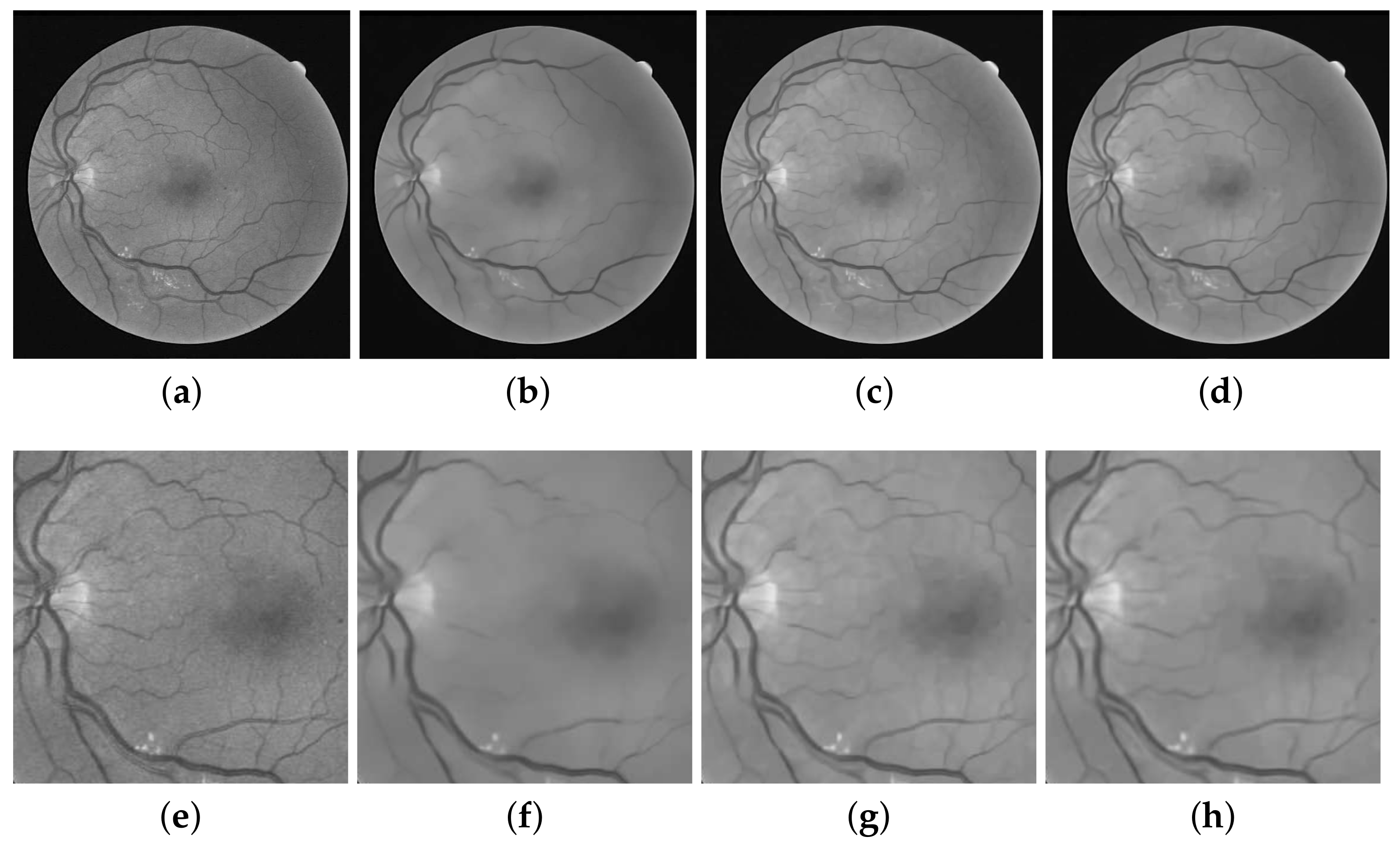

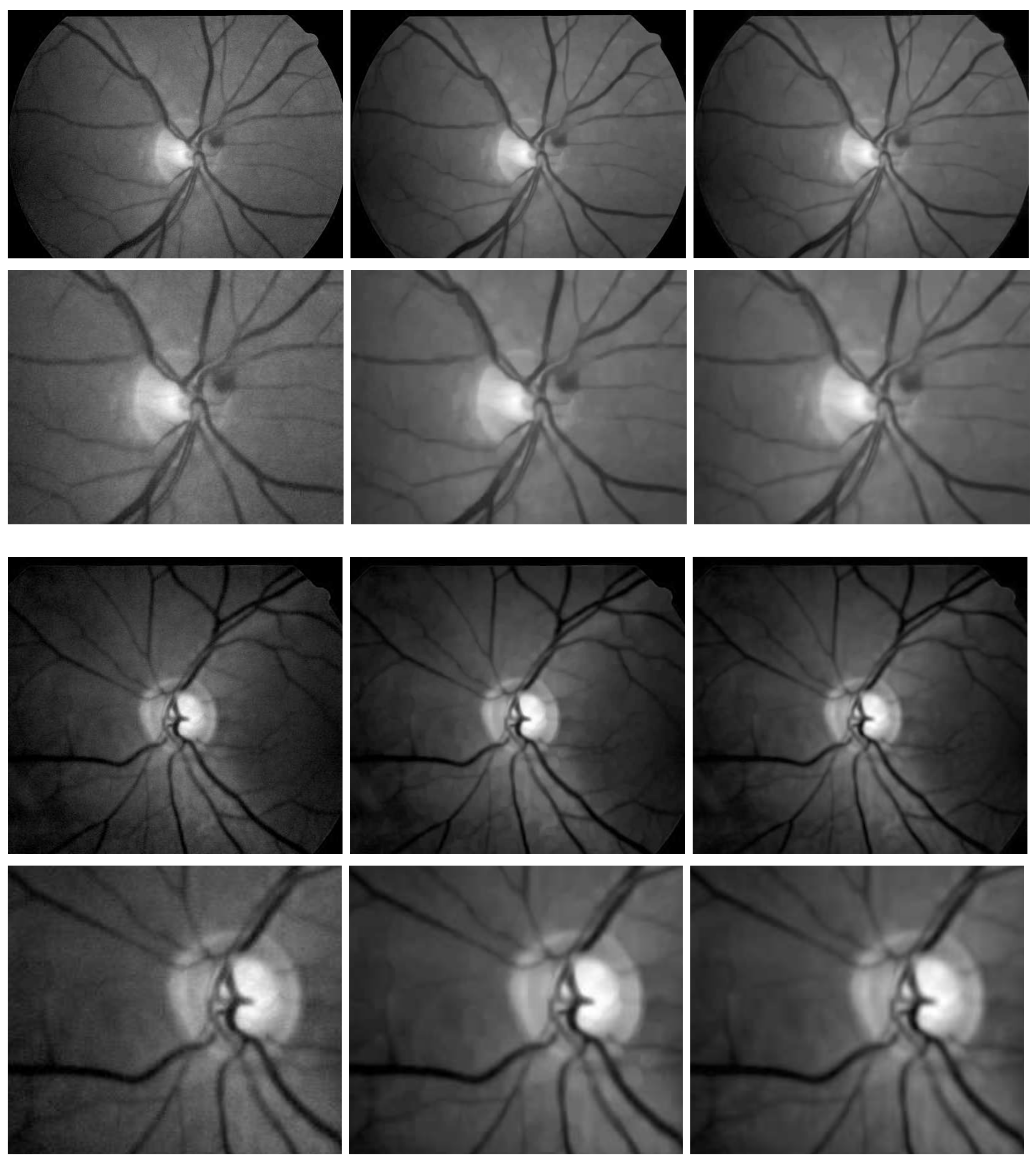
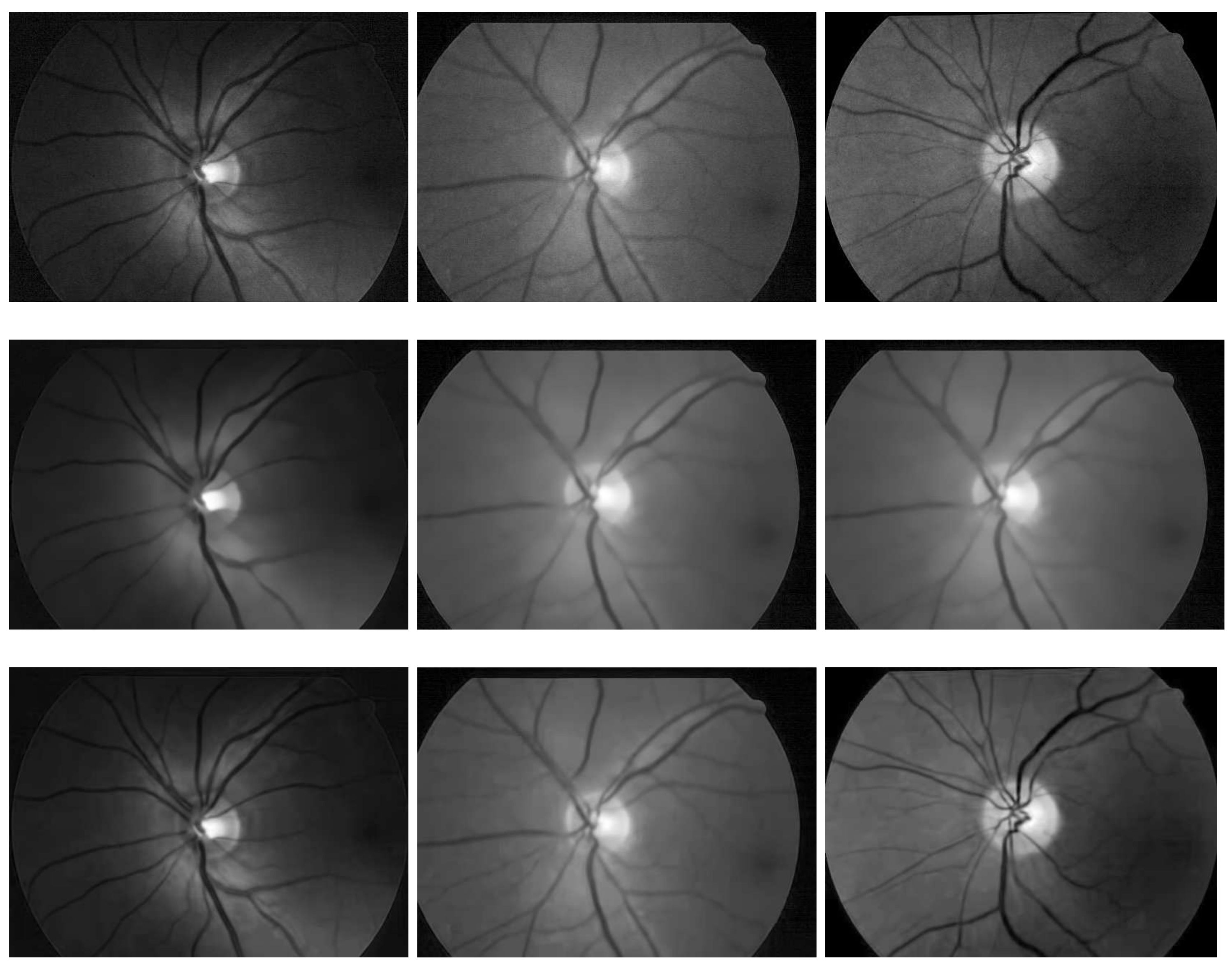

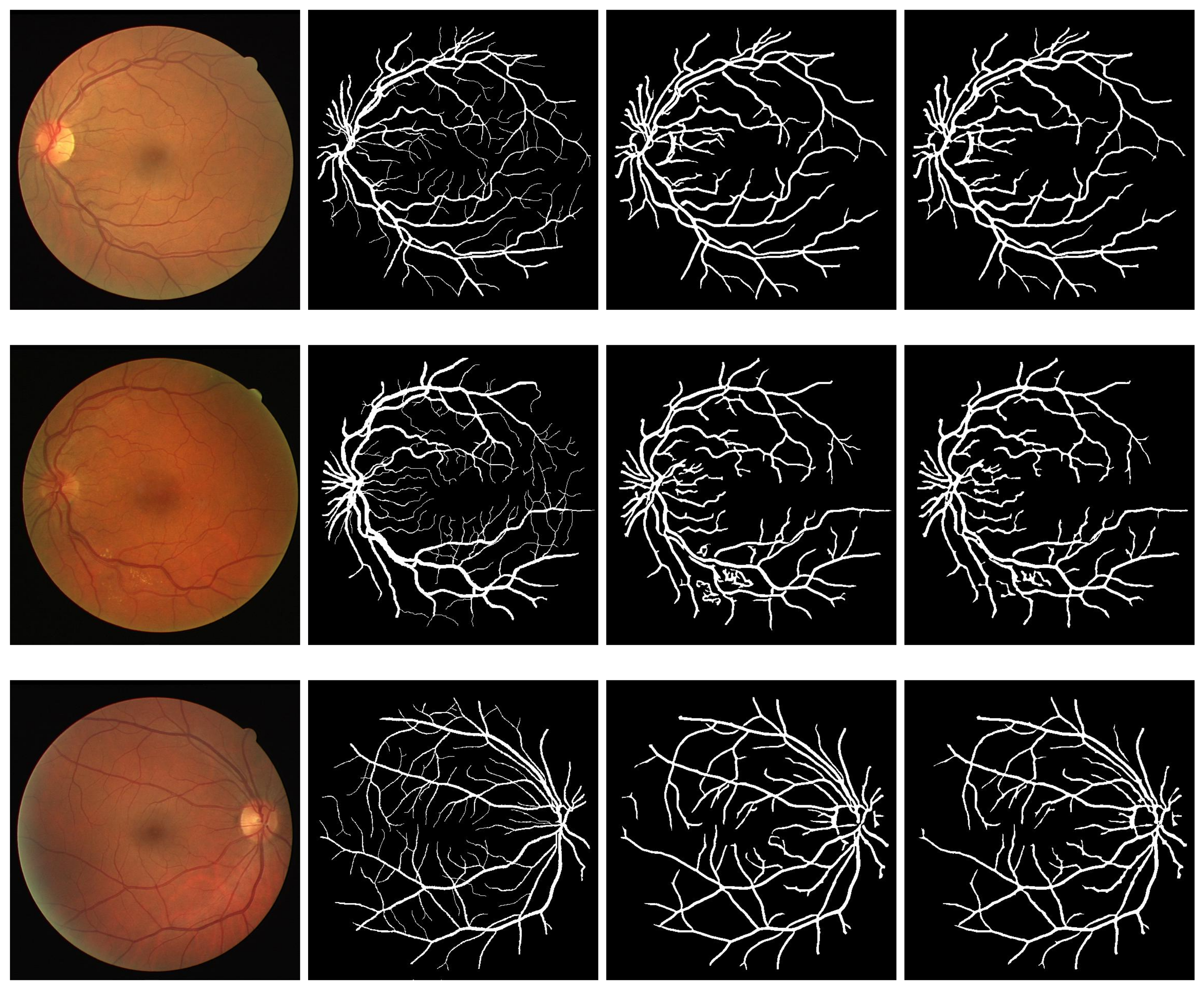
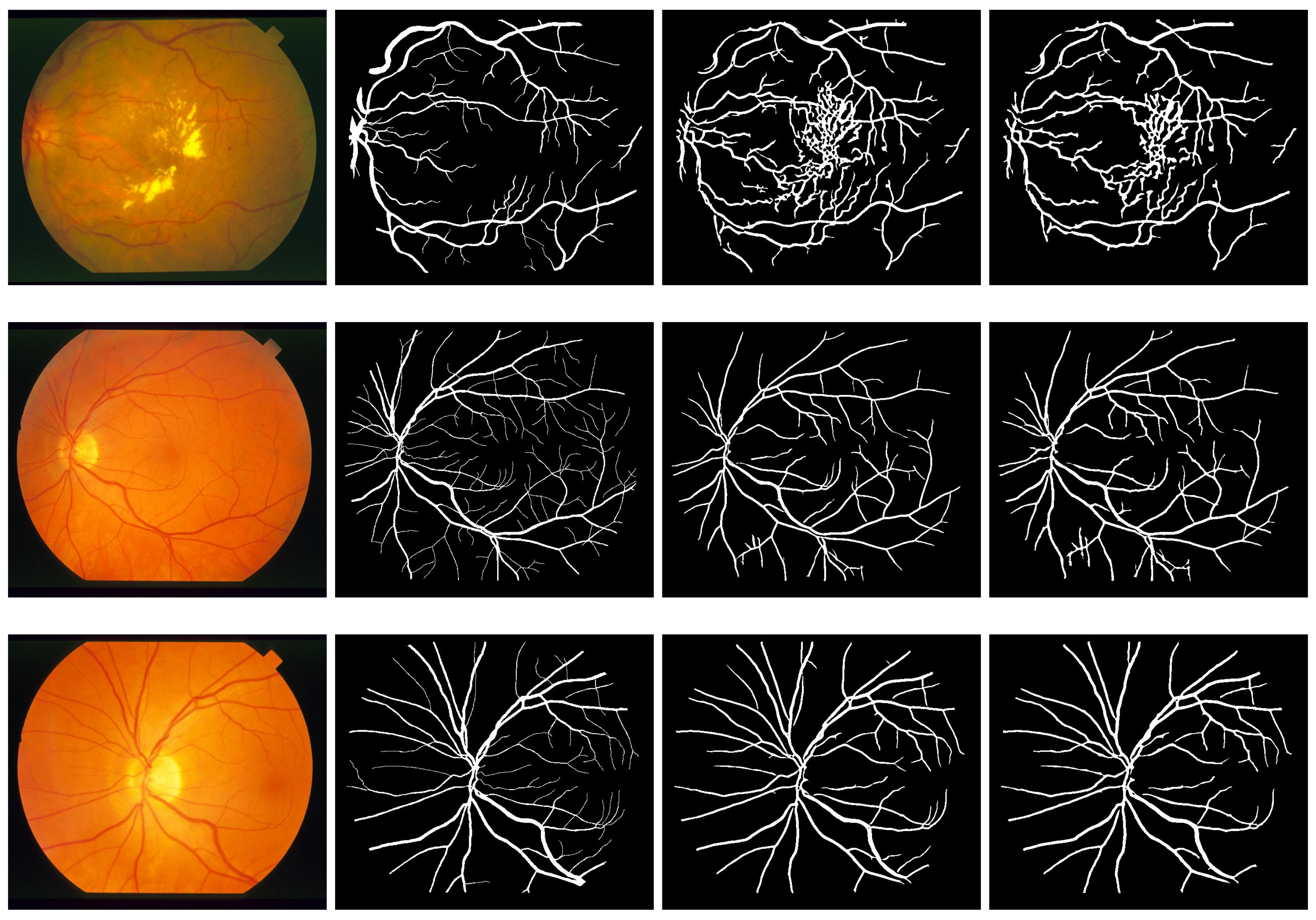



| ES-BM3D (FRANGI) | ES-BM3D (MULTISCALE) | ||
|---|---|---|---|
| STARE | Specifity | 0.9649 | 0.9653 |
| Sensitivity | 0.8056 | 0.8288 | |
| Accuracy | 0.9526 | 0.9541 | |
| DRIVE | Specifity | 0.9777 | 0.9702 |
| Sensitivity | 0.7687 | 0.8141 | |
| Accuracy | 0.9570 | 0.9540 | |
| CHASE_DB1 | Specifity | 0.9672 | 0.9711 |
| Sensitivity | 0.8203 | 0.8153 | |
| Accuracy | 0.9531 | 0.9561 |
| Type | Methods | Year | Se | Sp | Acc | AUC |
|---|---|---|---|---|---|---|
| Supervised methods | Li [78] | 2016 | 0.7569 | 0.9816 | 0.9527 | 0.9738 |
| Orlando FC [79] | 2017 | 0.7893 | 0.9792 | N.A | 0.9507 | |
| Orlando UP [79] | 2017 | 0.7076 | 0.9870 | N.A | 0.9474 | |
| Dasgupta [80] | 2017 | 0.9691 | 0.9801 | 0.9533 | 0.9744 | |
| Yan [81] | 2018 | 0.7653 | 0.9818 | 0.9542 | 0.9752 | |
| Hu [82] | 2018 | 0.7772 | 0.9793 | 0.9533 | 0.9795 | |
| Oliveira [83] | 2018 | 0.8039 | 0.9804 | 0.9576 | 0.9821 | |
| Alom [84] | 2018 | 0.7792 | 0.9813 | 0.9556 | 0.9784 | |
| Li [85] | 2019 | 0.8349 | N.A | 0.9563 | 0.9157 | |
| Jiang [86] | 2019 | 0.7839 | 0.9890 | 0.9709 | 0.9864 | |
| Unsupervised methods | Zhang [77] | 2016 | 0.7743 | 0.9725 | 0.9476 | 0.9636 |
| Karn [87] | 2018 | 0.78 | 0.98 | 0.97 | 0.88 | |
| Aguiree [88] | 2018 | 0.7854 | 0.9662 | 0.950 | N.A | |
| Khan [89] | 2018 | 0.730 | 0.979 | 0.958 | 0.855 | |
| Hashemzadeh [90] | 2019 | 0.7830 | 0.9800 | 0.9531 | 0.9752 | |
| Proposed (FRANGI) | 2019 | 0.7687 | 0.9777 | 0.9570 | 0.9554 | |
| Proposed (MULTISCALE) | 2019 | 0.8141 | 0.9702 | 0.9540 | 0.9399 |
| Type | Methods | Year | Se | Sp | Acc | AUC |
|---|---|---|---|---|---|---|
| Supervised methods | [78] | 2016 | 0.7507 | 0.9793 | 0.9581 | 0.9716 |
| [79] FC | 2017 | 0.7277 | 0.9712 | N.A | N.A | |
| Alom [84] | 2018 | 0.7756 | 0.9820 | 0.9634 | 0.9815 | |
| [81] | 2018 | 0.7633 | 0.9809 | 0.9610 | 0.9781 | |
| Oliveira [83] | 2018 | 0.7779 | 0.9864 | 0.9653 | 0.9855 | |
| Jiang [86] | 2019 | 0.7839 | 0.9894 | 0.9721 | 0.9866 | |
| Unsupervised methods | Zhang [77] | 2016 | 0.7626 | 0.9661 | 0.9452 | 0.9606 |
| Karn [87] | 2018 | 0.78 | 0.97 | 0.97 | N.A | |
| Hashemzadeh [90] | 2019 | 0.7737 | 0.9840 | 0.9623 | 0.9789 | |
| Proposed (FRANGI) | 2019 | 0.8203 | 0.9672 | 0.9531 | 0.9621 | |
| Proposed (MUTLISCALE) | 2019 | 0.8153 | 0.9711 | 0.9561 | 0.9565 |
| Type | Methods | Year | Se | Sp | Acc | AUC |
|---|---|---|---|---|---|---|
| Supervised methods | Li [78] | 2016 | 0.7726 | 0.9844 | 0.9628 | 0.9879 |
| Orlando FC [79] | 2017 | 0.7680 | 0.9738 | N.A | N.A | |
| Orlando UP [79] | 2017 | 0.7692 | 0.9675 | N.A | N.A | |
| Yan [81] | 2018 | 0.7581 | 0.9846 | 0.9612 | 0.9801 | |
| Hu [82] | 2018 | 0.7543 | 0.9814 | 0.9632 | 0.9751 | |
| Oliveira [83] | 2018 | 0.8315 | 0.9858 | 0.9694 | 0.9905 | |
| Alom [84] | 2018 | 0.8298 | 0.9862 | 0.9712 | 0.9914 | |
| Li [85] | 2019 | 0.8465 | N.A | 0.96733 | 0.9206 | |
| Jiang [86] | 2019 | 0.8249 | 0.9904 | 0.9781 | 0.9927 | |
| Unsupervised methods | Zhang [77] | 2016 | 0.7791 | 0.9758 | 0.9554 | 0.9748 |
| Karn [87] | 2018 | 0.80 | 0.96 | 0.96 | 0.88 | |
| Aguiree [88] | 2018 | 0.7116 | 0.9454 | 0.9231 | N.A | |
| Khan [89] | 2018 | 0.790 | 0.965 | 0.951 | 0.878 | |
| Hashemzadeh [90] | 2019 | 0.8087 | 0.9892 | 0.9691 | 0.9853 | |
| Proposed (FRANGI) | 2019 | 0.8056 | 0.9649 | 0.9526 | 0.9645 | |
| Proposed (MULTISCALE) | 2019 | 0.8288 | 0.9653 | 0.9541 | 0.9597 |
Publisher’s Note: MDPI stays neutral with regard to jurisdictional claims in published maps and institutional affiliations. |
© 2021 by the authors. Licensee MDPI, Basel, Switzerland. This article is an open access article distributed under the terms and conditions of the Creative Commons Attribution (CC BY) license (http://creativecommons.org/licenses/by/4.0/).
Share and Cite
Naveed, K.; Daud, F.; Madni, H.A.; Khan, M.A.U.; Khan, T.M.; Naqvi, S.S. Towards Automated Eye Diagnosis: An Improved Retinal Vessel Segmentation Framework Using Ensemble Block Matching 3D Filter. Diagnostics 2021, 11, 114. https://doi.org/10.3390/diagnostics11010114
Naveed K, Daud F, Madni HA, Khan MAU, Khan TM, Naqvi SS. Towards Automated Eye Diagnosis: An Improved Retinal Vessel Segmentation Framework Using Ensemble Block Matching 3D Filter. Diagnostics. 2021; 11(1):114. https://doi.org/10.3390/diagnostics11010114
Chicago/Turabian StyleNaveed, Khuram, Faizan Daud, Hussain Ahmad Madni, Mohammad A.U. Khan, Tariq M. Khan, and Syed Saud Naqvi. 2021. "Towards Automated Eye Diagnosis: An Improved Retinal Vessel Segmentation Framework Using Ensemble Block Matching 3D Filter" Diagnostics 11, no. 1: 114. https://doi.org/10.3390/diagnostics11010114
APA StyleNaveed, K., Daud, F., Madni, H. A., Khan, M. A. U., Khan, T. M., & Naqvi, S. S. (2021). Towards Automated Eye Diagnosis: An Improved Retinal Vessel Segmentation Framework Using Ensemble Block Matching 3D Filter. Diagnostics, 11(1), 114. https://doi.org/10.3390/diagnostics11010114








